By Darla Pompilio, (610) 847 5422, Your Tasks, Our Time
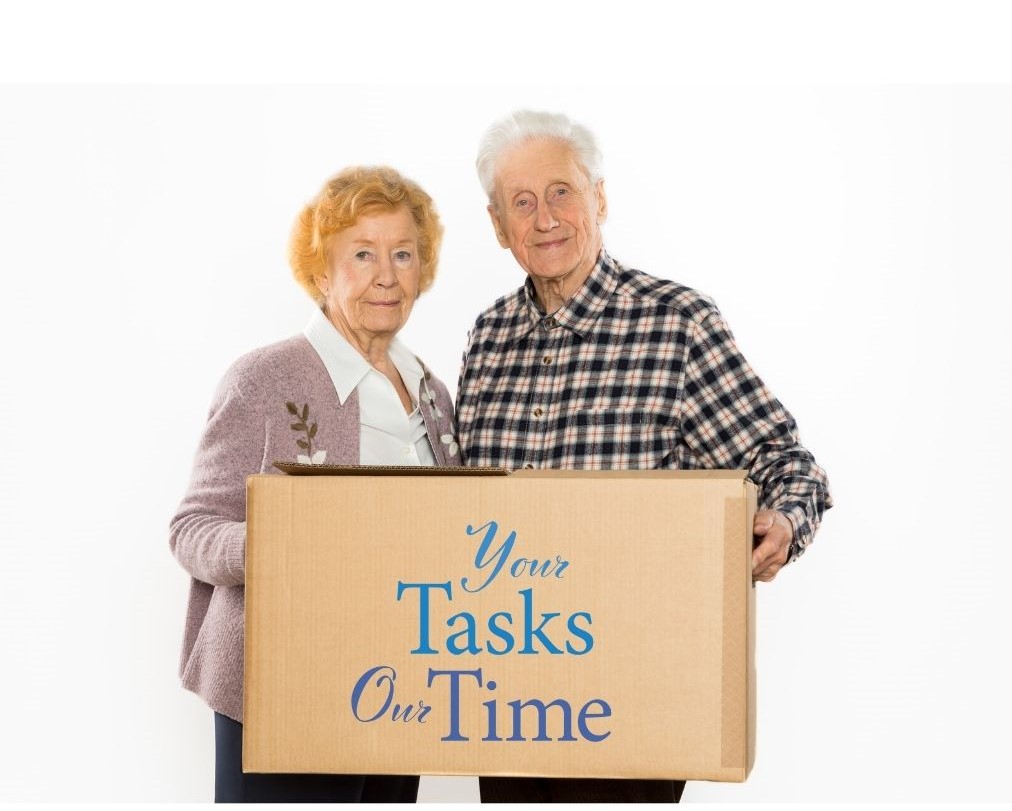
Do you have a parent or senior in your life that could benefit from downsizing their home but
you’re not sure how to approach the discussion? The topic of downsizing can be a difficult for
some. They may have to part with items that have memories attached. Or it may make them
feel like they are losing a piece of themselves. Below are some key aspects to ensure you have a
supportive and respectful discussion with the seniors in your life.
Before You Begin the Conversation
Before you start the conversation with your loved one, keep a few things in mind.
Be Respectful and Non-Judgmental
A Senior’s possessions represent a lifetime of memories. Dismissing their value as worthless is
equal to dismissing the senior’s value.
Don’t Lecture
Most seniors will respond well if you share your concerns and express your desire for them to
be in a safe and comfortable environment. It’s not about forcing them to get rid of things, it’s
about helping them to live their best life.
How to Begin the Conversation
How you start the conversation, and the tone you use, can impact the discussion either positively or negatively. Come from a place of support and love so they understand your desire to help them. Below is a list of questions you can use to get the conversation started.
Open-ended questions will be better to gain more information.
During the Conversation
Getting the conversation started is a step in the right direction. Keeping the conversation going in a positive direction is just as important. Remember these key points as you progress through your discussion.
Simply Listen
This is probably the most important step in the process. When seniors let go of their possessions, it often feels like a loss of control. By listening to their wants, needs and desires, you’re helping to ensure that they are maintaining control.
Ask Questions
Allowing seniors to tell stories about the past as you sort through their possessions can help ease some of the anxiety during the process of letting go.
Pick Your Battles
Arguing over every item is going to end with lots of hurt feelings and no progress. Letting go takes practice and patience. Keep reminding your loved one of the ultimate goal … for them to live their best life. It will get easier as they become more comfortable with letting go.
This process won’t be done overnight. It’s not uncommon to go through an entire home 2 to 3 times to achieve the desired goals. So be kind. Be patient. And remember, you may be in a similar situation yourself in the future.
By Kelly Galfand, JOY IN YOUR SPACE, 610-896-6896
My role as organizer usually involves helping people:
• live with less
• have more within easy reach
• love what they store.
One popular area I organize is wardrobe closets. Sometimes I’m hired to fix a physical problem; I solve storage challenges. Sometimes I am the necessary support as someone decides:
• what to keep
• where to donate or sell
• how to let clothes go.

In my experience, even when someone commits to trimming their wardrobe, there is one item they want to get rid of but (in their words) “can’t!” In these situations, what’s really behind their “can’t” is guilt.
When I hear a closet client say “I can’t get rid of this,” I know the clothing in question was either expensive, a gift, or it holds sentimental value.
• If the item was expensive… and they haven’t worn it (ever or enough), the struggle is about throwing good money away. But honestly, they’re wasting more money by storing this item. Waiting too long to resell something is not smart; the resale market pays more for recent purchases.
• Check out resale avenues like TheRealReal, PoshMark, Clothes Mentor, Plato’s Closet, and ThredUp depending on the item’s value.
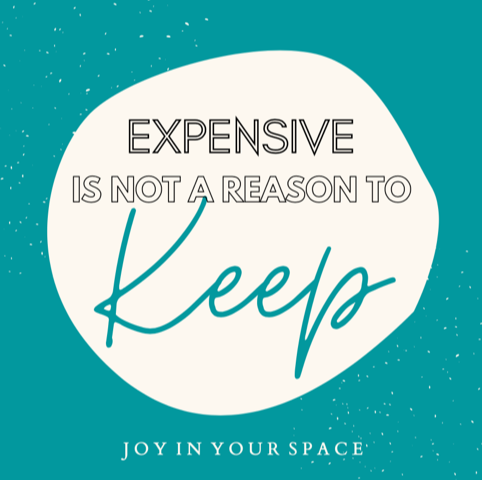
• If the item was a gift… from someone they love, their love for the person is getting in the way of their ability to decide what they want in their life. They sometimes think that letting the item go is akin to rejecting the gift-giver’s love, kindness, or generosity. Trust me, your favorite aunt knows you love her even if you don’t love the winter hat she gave you. I always reassure clients that no one gives a gift in order to burden the recipient. A recipient’s only responsibility is to be gracious in accepting the gift.
• —You can always donate the item or its value to a charitable organization the gift-giver supports to lessen the pain of letting the item go from your life. Let it be a gift that keeps on giving — to someone else!

• If the item holds memories it will fall into one of two categories:
• Clothing from the person’s own life (even if it was someone else’s at some point)
When I come across these sentimental clothes, the first question I ask is: Will you still wear it? If the answer is “yes,” it can stay.
If the answer is “no,” then I suggest the t-shirt, wedding gown, or cheerleading skirt move to a spot more suitable to memories and nostalgia.
• Clothing that holds memories may have belonged to a deceased loved one. I help people navigate these sensitive areas often. What I counsel, is to keep only the sweatshirts, t-shirts, or hats that meant something to the departed and mean something still to you if you have room for it.
If it’s something you aren’t going to wear, display it to honor it in some way. Shadow boxes are wonderful conversation pieces and visual reminders of our ancestors’ legacies.
To me, your adored Uncle’s memory does not hinge on a single t-shirt…not even on his entire t-shirt collection. I recommend that if you let items go from your life (that belonged to someone you loved) decide how you will remember this person (in thought or deed) once you let the item go. Then be intentional in keeping their memory alive.
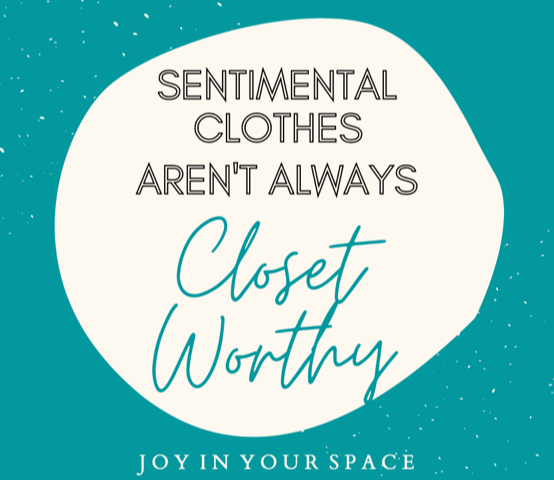
Infants grow fast — I’ve had piles of clothes to prove this fact. Nearly as fast as they’ve grown into their newest cute new outfits, they’ve outgrown them already! Having a plan for keeping up with this constant rotation will save you time in the future and reduce the stress of potential growing piles. Whether or not you hope to use the clothes for future children, here are a few quick-to-tackle tips for getting ahead of the clothing clutter.
Not saving anything? Get ahead of the clutter.
Determine the spot you’ll use for temporarily stashing outgrown items. I use a basket under my son’s crib, but you can use a paper bag, box, or large trash bag on a shelf or in a closet. The laundry room is a great place, too. From now on, every time you determine something no longer fits your child, put it in your temporary storage bin. Add to this bin until it’s full, then mark it with the approximate size(s), stick the box/bag in your car, and drop it off for donation. Likely you have friends with kids and could also drop off the box on a porch for hand-me-downs. More on donations at the end.
If you know you’ll be keeping some clothes for future children, read on.
Get Clothes Prepped for Future Kids
First, determine a spot you’ll use for temporarily stashing outgrown items. I use two baskets under my son’s crib, one for items I’m keeping and one for giving away, but you can use paper bags or boxes in the laundry room, on a shelf or in a closet, or large trash bags (clearly marked and stored out of reach of the littles), etc.
Next, Every.Single.Day and Every.Time you determine something no longer fits your child, decide if you liked this outfit/item and put it in the keep bin, if not, put it in your give-away bin. Add to these bins until full. Then transfer the give-away items to a box marked with the approximate size(s) and check out donation options below. For the clothes you’re keeping, transfer to a storage bin, vacuum sealed bag or other favorite storage solution. I tend to have extra diapers that are outgrown, so I fill diaper boxes with unused/outgrown diapers and clothing from roughly the same size. Taking 1 minute each day will save you the hassle of sorting through a huge pile later.
Options for Clothes You’re Not Keeping
Depending on your interest and time commitment, you have a few options in addition to those mentioned above. From approximately most to least time consumed:
Final Thoughts on Outgrown Clothing
It’s best to donate items you’d use again and toss anything too worn out. If your kids are older and aware of “favorite” pieces, go through this process with them, so they learn from you how to stay organized and be generous with their clothes! For the babies, an everyday, constant rotation keeps clothes that fit available and stops piles from accumulating to keep the nursery looking lovely.

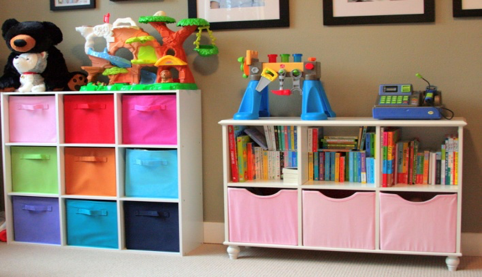
Written by Cathy Kay, Four Corners Organizing LLC
As a new-ish mom, and someone that works with clients that have kids, a HUGE hurdle to tackle is a child’s toy room. No matter how big your “toy room” is, it seems that the kids’ toys take over all rooms of the house. I don’t know about you, but I wasn’t really going for a Mickey Mouse aesthetic when we moved in.
Nonetheless, it has happened. So what’s the best advice for those who try to keep a clutter free home while also letting “kids be kids?” Let me count the ways!
1.) Label as much as you can.
A huge reason why it’s difficult for some kids to put away their toys is because they don’t know where things go. An easy way to keep games and toys that have a lot of pieces “contained” is purchasing a clear, multiple compartment drawer and labeling each compartment. This can be done with a label maker or even letting the kids help out and make their own labels! This is good for toys such as Legos, Kinex, Barbies, etc. This way, the kids know exactly where everything goes when it’s time to clean up.
2.) Big toys = Big problems.
I know a larger than life issue for me includes the “big toys”. Huge racecar tracks, kitchen sets, dollhouses, you name it. If you have an additional storage area available, such as a portion of your basement or spare bedroom, a toy rotation is your best bet. Put a few “big toys” out for a week, and then switch them out every other week. Once you start noticing your little ones have a favorite and keep going back to the same toy,
it may be time to add to the donation pile! This will keep those big toys from overflowing into every part of your home.
3.) Make cleaning up a game!
There’s nothing kids like more than a game, especially if they can win it! When there’s about 20 minutes left until bed time, or lunchtime (whenever the kids need to get their area cleaned up), set the timer. Tell them whoever gets their toys cleaned up first gets an extra story at bedtime, or their choice of dessert; something that they would really appreciate and enjoy.
Hopefully this will help those of you who dread looking at the toy room and can see see a light at the end of the tunnel. And hey, at least Christmas isn’t for another ten months!
Hopefully this will help those of you who dread looking at the toy room and can see see a light at the end of the tunnel. And hey, at least Christmas isn’t for another ten months!
By Geri Chark Frankel, GCF Organizing LLC, (856) 296 6605

Kudos to you! Somehow you have found a few minutes to read this blog during this busy holiday season. How did you manage it?
Is it a much-needed break from work? Are you avoiding a task you just can’t face right this minute? Are you a passionate follower of all things about organizing? Do you want to honor your NAPO colleague by reading her words?
I am curious about your answers, and welcome you to explore them. First, there is no right answer. There is YOUR answer. And to get to that answer, I’d like to you give yourself permission to:
STOP – PAUSE – REFLECT. Did any insights rise up? Did you get a glimmer of what your priorities are? Should be?
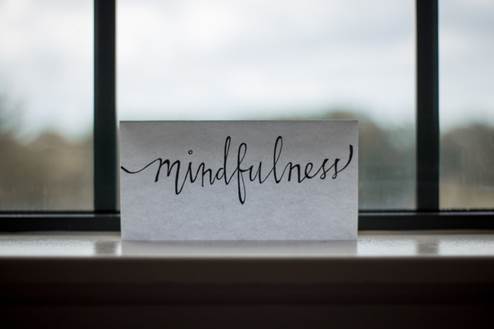
Now let’s take this tool and use it as you head into a New Year… and into any organizing/time management/productivity project large or small about which you feel stuck.
For example, you have a huge amount of memorabilia: inherited from relatives, reminders of your childrens’ youth, and your own school, personal and work papers. This stuff all reminds you with what your life has been woven together. Maybe it even symbolizes your core identity. It’s hard to let to go. Even editing them down, creating digital (photos, scans) records of them does not seem possible.
So let’s STOP PAUSE REFLECT. And ask yourself this: What Matters Most To Me NOW? Is it making room for other activities in the space now clogged with memories of the past? Is it giving myself a beautiful space in which to create my life today? What are my core needs and values, and how might they be best served?
In my experience working with hundreds of clients over the years, they all know these answers, deeply and profoundly. Decluttering and creating a life that reflects who they want to be is greatly facilitated by taking the time and energy to develop the self-awareness that bursts forth from mindfulness. Give it a try!
Wishing you joy during this holiday season,
Geri Chark Frankel
GCF Organizing LLC
By Adriane Weinberg, An Organized Approach, (215) 540 9401

Let’s admit it. We Americans have Too Much Stuff. And we don’t get rid of nearly enough. Reasons from clients include: it feels impersonal donating things to unknown people or they’re saving stuff for their kids (hey, your kids don’t want it). What if there were a way to give things away that feels good? There is! Buy Nothing groups.
The purpose of Buy Nothing Groups is to give away unwanted items, or request items that are wanted, for free. It’s based on the ancient practice of gift economies where people share and pool resources. The Buy Nothing Project started as a social experiment by two friends, Rebecca Rockefeller and Liesl Clark, in July 2013.
Groups are hyper-local and found on Facebook, which was chosen because it’s a free, widely used platform. The rules are simple. From their website, “Post anything you’d like to give away, lend, or share amongst neighbors. Ask for anything you’d like to receive for free or borrow. Keep it legal. No hate speech. No buying or selling, no trades or bartering, we’re strictly a gift economy.” Easy enough.
These ladies couldn’t have imagined that their little experiment would become a worldwide movement with 1.3 million users in 28 countries and 6,000 volunteers!
For more information or to find a Facebook group in your area, visit https://buynothingproject.org/. Rebecca and Liesl are currently crowdfunding to create a social media platform and app (https://www.soop.app/) to enhance “the power of shared abundance.” Their recently published book, The Buy Nothing, Get Everything Plan: Discover the Joy of Spending Less, Sharing More and Living Generously, shows people how to be a smarter shopper and get rid of things without adding to landfills.
On a related note, Buy Nothing Day is the Friday after Thanksgiving, aka Black Friday. It’s an international day of protest against overconsumption. This year, it’s Friday, November 27, if you’d like to participate.
I’m not anti-stuff. In fact, I have lots of stuff. My house isn’t cluttered, there’s ample space and I can find anything in seconds. For several years, a few years ago, I avoided shopping because I have what I need and much of what I want. I have enough. I don’t buy much anymore, unlike when I was acquiring things in my 20s, 30s and 40s. As a professional organizer, I know it’s about moderation and space. Everyone should do what feels right for their situation.
Many people lost jobs due to COVID-19. Buy Nothing Groups are a great way to save money. Or help neighbors save money by gifting things to them. Maybe you’ll be inspired to check out a Buy Nothing group.